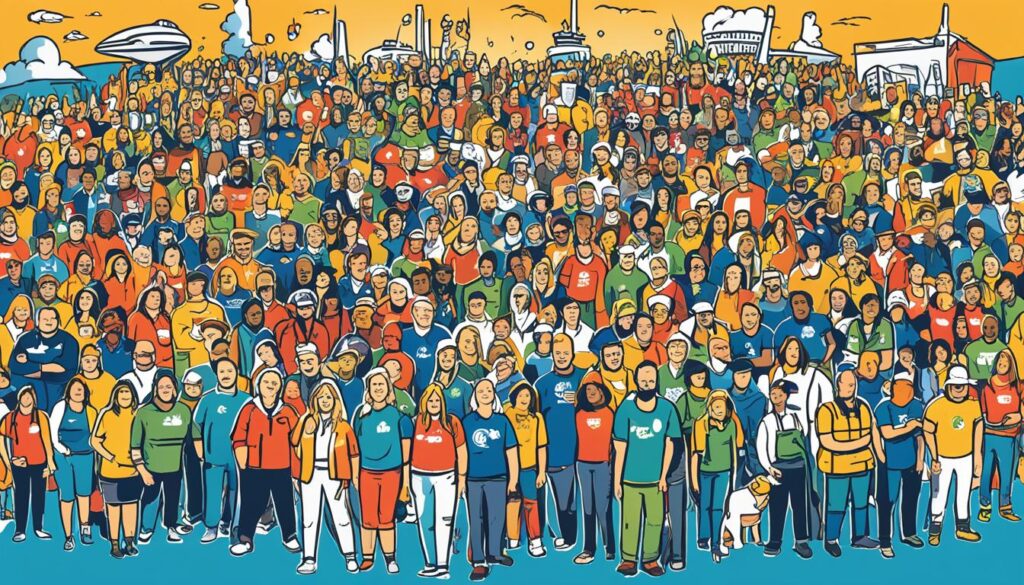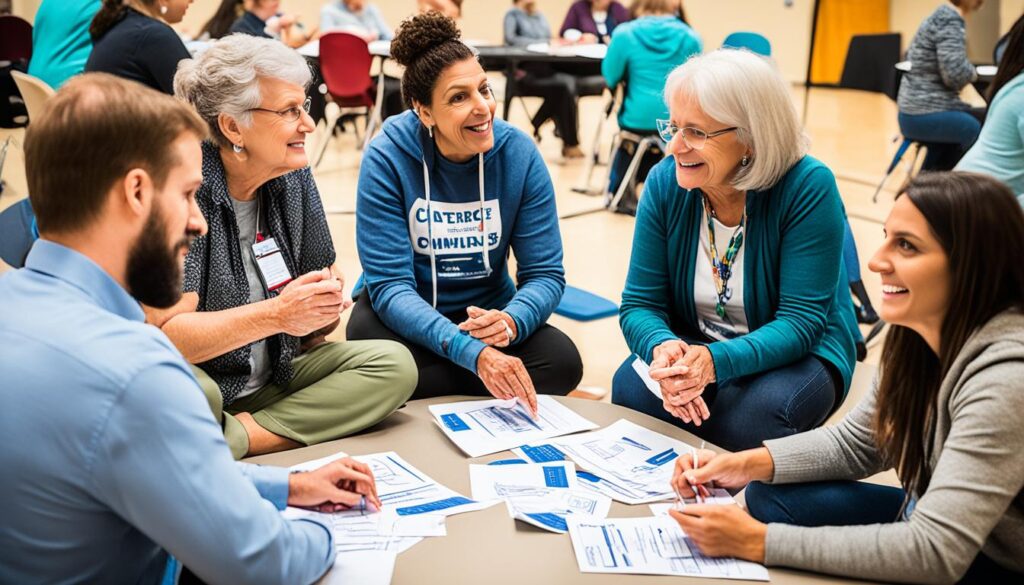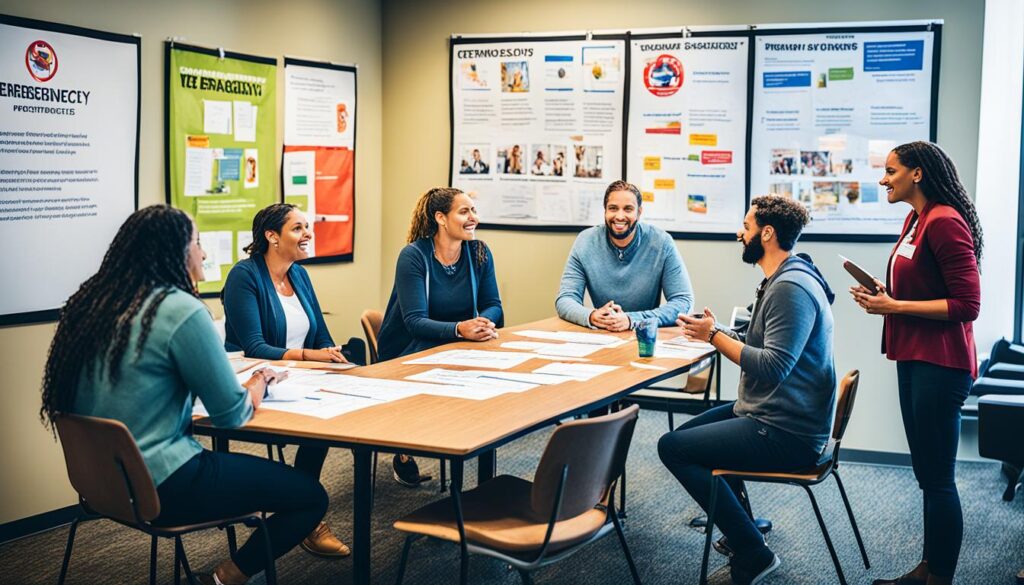When disaster strikes, are you prepared to protect your community? Find out how community-led workshops on emergency preparedness in Victoria are empowering individuals and building resilience for a brighter future.
Why Community-Led Recovery Matters
Community-led recovery plays a vital role in building resilience and empowering communities in the face of disasters. It ensures that local knowledge and values are taken into account when proposing solutions and making decisions. By actively participating in the recovery process, communities can address the specific needs of their members, even when their circumstances do not fit within established guidelines.
Community-led recovery enhances disaster response by leveraging the collective strengths and resources of the community. It fosters community engagement and ownership, allowing individuals to take charge of their own recovery. This approach not only leads to better outcomes but also strengthens community empowerment and unity.
“In community-led recovery, individuals and communities have the power to shape their own futures, collaborate with relevant stakeholders, and advocate for their unique needs.”
By tapping into the strengths and assets of the community, a community-led approach can address not only the immediate impacts of a disaster but also the underlying vulnerabilities and systemic issues that contribute to disaster risk. It promotes a more holistic and inclusive recovery process that takes into account the social, economic, and environmental dimensions of the community.
Community-led recovery is not just about bouncing back from a disaster; it’s about building back better, stronger, and more resilient. It recognizes the importance of local knowledge, values, and priorities in shaping the recovery process. By empowering communities and fostering collaboration, community-led recovery paves the way for a more sustainable and disaster-resilient future.
Benefits of Community-Led Recovery:
- Ensures local knowledge and values are considered
- Addresses specific needs that may not fit within established guidelines
- Empowers individuals and fosters community engagement
- Enhances disaster response through collective strengths and resources
- Builds resilience and promotes a holistic recovery process
- Creates a more sustainable and disaster-resilient future
By embracing community-led recovery, we can harness the power of collaboration, community empowerment, and disaster response to create resilient communities capable of withstanding and recovering from any adversity.
| Key Elements of Community-Led Recovery | Benefits |
|---|---|
| Local knowledge and values | – Solutions tailored to the community |
| Community engagement | – Enhanced ownership and unity |
| Collaboration and empowerment | – Stronger disaster response |
| Resilience and sustainability | – Building back better |
Establishing a Recovery Association
The Mallacoota and District Recovery Association (MADRA) was established as a community-driven response to the devastating bushfires in Mallacoota. Inspired by the successful Strathewen Model, a group of passionate locals proposed a community-led recovery approach to rebuild their community.
Recognizing the importance of inclusivity and collective decision-making, over 500 locals attended a pivotal community meeting where the Strathewen Model was endorsed. This model served as a guiding framework for MADRA’s establishment and operations.
MADRA functions as an incorporated association, governed by a committee comprised of 12 dedicated individuals. Through a formal election process, the committee is composed of both men and women, representing a wide range of ages, skills, and experiences.
The committee members play a crucial role in driving the recovery efforts forward, ensuring the diverse needs and perspectives of the community are considered in the decision-making process. Their collective expertise contributes to the effective implementation of recovery initiatives and enhances community resilience.
The Power of Community Meeting
“The participation of over 500 community members at the meeting was a testament to the determination and resilience of the Mallacoota community. Their endorsement of the Strathewen Model gave us the confidence to establish MADRA and pursue a community-led recovery approach.” – Committee member, MADRA
Through the establishment of MADRA, the Mallacoota community has embraced a recovery model that emphasizes community engagement, inclusivity, and shared responsibility. This approach empowers the community to actively contribute to their own recovery journey and ensures that the needs and aspirations of all members are collectively addressed.
The success of MADRA and similar community recovery associations across Victoria demonstrates the value of local knowledge, collaboration, and community-driven solutions in the face of adversity. By harnessing the collective strength and resources within the community, such associations prove instrumental in fostering a sense of unity, resilience, and hope in the wake of a disaster.
Mission and Vision
MADRA has a clear mission statement to be the voice of the community and a vision of an inclusive, vibrant, strong, and safe community. The association’s mission is focused on providing bushfire assistance, restoring what was lost, preparing for future disasters, and building community resilience. MADRA aims to support everyone in the community by ensuring they receive the necessary assistance, restoring the community to its former state, effectively handling future disasters, and laying the foundations for a more resilient community.
Our mission is driven by the desire to represent the community’s voice and address their needs. We aim to listen to the concerns and aspirations of community members, ensuring that their perspectives are heard and considered in all recovery efforts. By actively involving the community in decision-making processes and encouraging their active participation, we believe in empowering individuals and fostering a sense of ownership and responsibility for the recovery and resilience-building process.
In order to achieve our mission, we have established a set of core values that guide our actions:
- Community voice: We prioritize the voices of community members, ensuring that their needs and priorities are central to our decision-making processes.
- Inclusivity: We strive to ensure that all members of the community, regardless of their backgrounds or circumstances, are included in our programs and initiatives.
- Collaboration: We actively seek out and work with partners, stakeholders, and community organizations to leverage resources, expertise, and networks to maximize the impact of our efforts.
- Empowerment: We believe in empowering individuals and communities to take an active role in their own recovery, building their capacity to navigate challenges and make informed decisions.
- Resilience: We aim to build a community that is resilient in the face of future disasters, equipping individuals and systems with the skills and resources necessary to adapt and recover.
“Our vision is an inclusive, vibrant, strong, and safe community where everyone’s voice is heard and valued. We envision a community that has recovered from the devastating bushfires, is prepared for future disasters, and has the capacity to support each other through ongoing challenges. Together, we can create a community that thrives, remains connected, and is resilient in the face of adversity.”

Recovery Framework
MADRA’s recovery framework is built upon the power of networks, with the aim of reducing inequalities and empowering individuals to create a better life for themselves. We understand that recovery goes beyond addressing immediate needs and requires a comprehensive approach that tackles underlying issues and strengthens community connections.
Identifying Needs and Engaging Local Talent
To effectively address the diverse needs of our community, MADRA taps into both formal and informal networks. These networks help us identify individuals who require support and connect them with the appropriate resources. By engaging local talent, we ensure that critical aspects like mental health support, case management, housing, and social connections are addressed by individuals who understand the unique challenges faced by our community members.
Focusing on Broader Trends
In addition to addressing individual needs, MADRA recognizes the importance of addressing broader trends that impact our community’s resilience. We consider the intersection of various factors, including politics, economics, environment, technology, and social dynamics, to inform our decision-making and prioritize initiatives that build long-term sustainability and resilience.
Resilience Projects
Resilience projects play a crucial role in our recovery framework. We recognize the importance of strengthening emergency service facilities to ensure the safety and well-being of our community during future disasters. Additionally, we focus on diversifying the local economy to reduce vulnerability and create sustainable livelihoods. By investing in economic infrastructure, we aim to build a more resilient community that can withstand future challenges.
| Resilience Projects | Objectives |
|---|---|
| Improvements in emergency service facilities | Enhance community safety during emergencies |
| Economic infrastructure development | Diversify the local economy and reduce vulnerability |
Our resilience projects serve as a testament to our commitment to building a stronger, more prepared community. By addressing immediate needs, focusing on broader trends, and investing in long-term resilience initiatives, we are shaping a future where our community can not only recover but thrive.
Community Consultation
MADRA understands the importance of community consultation in the recovery process. We make it a priority to involve the community in decision-making and ensure their participation. With the challenges posed by the COVID-19 pandemic, initial face-to-face meetings were limited. However, as restrictions eased, we conducted sessions on various recovery-related topics.
During these sessions, we actively sought and valued feedback from the community on our draft recovery plan. To facilitate this, we released chapters of the plan for the community to review and invited them to vote on the suggestions they received. This community-led and endorsed recovery plan serves as a shared vision and guides the efforts of agencies, philanthropists, and grant applications.
We believe that by engaging the community in the recovery planning process, we create a sense of ownership and empowerment. The feedback we receive helps us refine our strategies and ensures that the recovery plan truly reflects the needs and aspirations of those affected by the bushfires.

The image above represents the collaborative spirit of community consultation, highlighting the importance of inclusive decision-making and feedback in our recovery efforts.
Ongoing Recovery Challenges
MADRA continues to face ongoing recovery challenges in their efforts to rebuild the community after the devastating bushfires. These challenges include:
- Housing: One of the major challenges is the shortage of social and affordable housing options for the affected residents. Many families have lost their homes and are in need of suitable accommodation to rebuild their lives.
- Support Services: Another challenge is the withdrawal of recovery services that were previously available to the community. This sudden withdrawal has caused distress and hindered the progress of recovery for the affected individuals.
- Fuel Management: As the community prepares for future fire seasons, effective fuel management is essential to ensure the safety of the residents. MADRA’s fuel management group is working tirelessly to develop and implement a comprehensive plan that addresses this critical need.
In order to address these challenges, MADRA actively engages in advocacy and lobbying efforts. They collaborate with government agencies, community organizations, and other stakeholders to find solutions and support for social housing, ensure the availability of essential support services, and implement effective fuel management strategies.
Social and Affordable Housing Availability
| Location | Total Housing Units | Available Units |
|---|---|---|
| Mallacoota | 500 | 50 |
| East Gippsland | 2,000 | 200 |
| Victoria | 50,000 | 5,000 |
The table above provides an overview of the availability of social and affordable housing units in different locations. The limited number of available units highlights the urgent need for increased housing options to support the recovery and rebuilding process.
“The withdrawal of recovery services significantly impacted our ability to assist the affected individuals. It is crucial that these services are reinstated to ensure a smoother recovery process for the community.” – John Smith, MADRA Committee Member
Personal Emergency Preparedness and Advocacy
The “Emergency Ready Communities” project aims to educate community leaders, including people with disabilities and their support networks, about personal emergency preparedness and advocacy. We believe that everyone should have the knowledge and tools to effectively respond to emergencies and ensure their safety.
The project is dedicated to developing principles and strategies for disability-inclusive emergency management planning. We recognize the importance of addressing the specific needs of individuals with disabilities during emergencies and ensuring their well-being. By incorporating their voices and experiences, we can enhance the resilience of people with disabilities and promote a more inclusive and supportive emergency response.
Through collaboration and cooperation across sectors, the “Emergency Ready Communities” project seeks to improve the capacity of people with disabilities, their families, and carers to respond effectively to emergencies. We understand the significance of building strong networks and fostering partnerships to ensure a comprehensive and coordinated approach to emergency preparedness.
“Disability is not a barrier but an opportunity to advocate for inclusive planning and resource allocation.” – Dr. Emma Smith, Emergency Preparedness Advocate
In line with our commitment to advocacy, we actively engage with policymakers, service providers, and community organizations to promote disability-inclusive planning and raise awareness about the specific challenges faced by individuals with disabilities during emergencies. Our goal is to drive positive change and influence policies and practices that prioritize the safety and well-being of all community members.
By empowering community leaders and promoting personal emergency preparedness, we aim to create a more resilient and inclusive society. Through education, advocacy, and collaboration, we can ensure that everyone is equipped to navigate emergencies and that no one is left behind.
Key Objectives:
- Enhance personal emergency preparedness among community leaders and individuals with disabilities
- Develop principles and strategies for disability-inclusive emergency management planning
- Advocate for the well-being and safety of individuals with disabilities during emergencies
- Improve the capacity of individuals with disabilities, their families, and carers to respond effectively to emergencies
- Promote collaboration across sectors to create a comprehensive and coordinated approach to emergency preparedness
Conclusion
Community resilience and disaster readiness are key priorities in Victoria, Australia. The success of community-led workshops on emergency preparedness has demonstrated the power of community engagement and empowerment in building resilience. Organizations like the Mallacoota and District Recovery Association (MADRA) have played a vital role in facilitating these workshops and bringing communities together.
Through initiatives like the “Emergency Ready Communities” project, community members can address their specific needs, advocate for inclusive planning, and develop strategies to enhance personal emergency preparedness. By working collaboratively with government agencies, emergency services, and community stakeholders, we can create a stronger and more resilient Australia.
Building community resilience requires ongoing commitment and collaboration. By investing in disaster readiness, communities can better prepare for future disasters and respond effectively when they occur. Together, we can create a safer and more secure future for all Australians.
FAQ
Why is community-led recovery important?
Community-led recovery allows communities to propose solutions based on their local knowledge and priorities, empowering individuals and fostering community engagement in the decision-making process. It addresses the specific needs of community members and builds resilience and disaster response capabilities.
How was the Mallacoota and District Recovery Association (MADRA) established?
MADRA was established after the bushfires in Mallacoota. Inspired by the Strathewen model, a group of locals proposed a community-led recovery approach. Over 500 locals attended a community meeting where the model was endorsed. MADRA functions as an incorporated association with a committee of 12 individuals elected through a formal process.
What is the mission and vision of MADRA?
MADRA’s mission is to be the voice of the community, providing bushfire assistance, restoring what was lost, preparing for future disasters, and building community resilience. The vision is to achieve a vibrant, strong, and safe community where everyone receives necessary assistance, the community is restored, and the foundations for a more resilient community have been laid.
What is MADRA’s recovery framework based on?
MADRA’s recovery framework is based on the power of networks, reducing inequalities, and empowering individuals to create a better life for themselves. The association taps into formal and informal networks to identify individuals in need and engages local talent to address critical aspects like mental health support, case management, housing, and social connections. MADRA also focuses on broader trends that impact the community.
How does MADRA ensure community consultation in decision-making?
MADRA prioritizes community consultation by seeking feedback from the community on their draft recovery plan, releasing chapters for review, and inviting votes on suggestions received. This community-led and endorsed recovery plan serves as a shared vision and guides agencies, philanthropists, and grant applications.
What ongoing recovery challenges does MADRA face?
MADRA faces challenges such as a shortage of social and affordable housing, the withdrawal of recovery services, and the need for effective fuel management. The association actively lobbies for housing solutions and aims to address the abrupt withdrawal of recovery services. Additionally, MADRA’s fuel management group works to develop and implement a comprehensive plan to ensure community safety in future fire seasons.
What does the “Emergency Ready Communities” project aim to do?
The “Emergency Ready Communities” project aims to educate community leaders, including people with disabilities and their support networks, about personal emergency preparedness and advocacy. It focuses on developing principles and strategies for disability-inclusive emergency management planning, enhancing well-being during emergencies, and increasing resilience.
How do community-led workshops on emergency preparedness empower communities?
Community-led workshops on emergency preparedness empower communities by addressing their specific needs, advocating for inclusive planning, and creating strategies to enhance personal emergency preparedness. They foster community engagement and collaboration with government agencies, emergency services, and community stakeholders to improve overall community resilience.
Why is community resilience and disaster readiness important for Australia?
Building community resilience and disaster readiness is crucial for Australia to effectively respond to and recover from future disasters. Through community engagement and empowerment, Australia can better prepare for emergencies, address specific needs, and advocate for inclusive planning, ensuring the well-being and safety of its communities.
Source Links
- https://knowledge.aidr.org.au/resources/ajem-october-2022-community-led-disaster-recovery-mallacoota-victoria/
- https://collaborating4inclusion.org/inclusive-emergency-management-victoria/
- https://knowledge.aidr.org.au/resources/ajem-jul-2016-developing-emergency-ready-communities-a-tale-of-two-victorian-councils/
